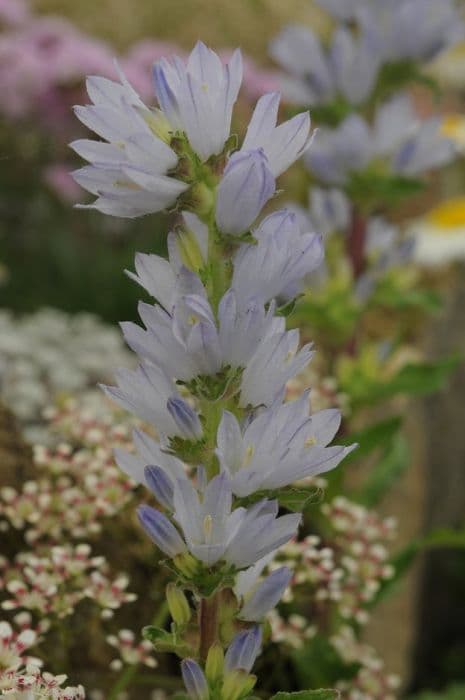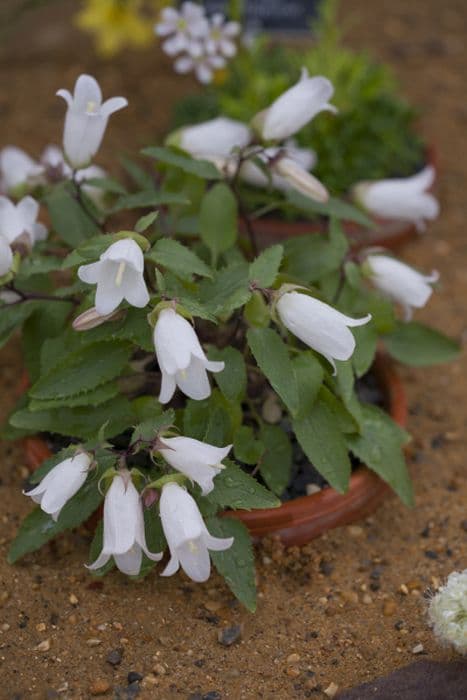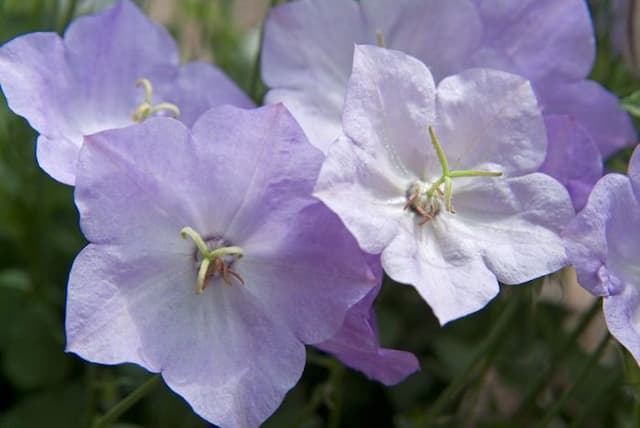Macedonian Harebell Campanula moesiaca

ABOUT
Campanula moesiaca, commonly known as the Bellflower, is a charming perennial plant recognized for its beautiful floral display. The plant has a basal rosette of leaves from which emerges a flowering stem. The leaves are typically oval-shaped with a toothed margin, and they are a lush green, creating an attractive contrast with the flowers. The Bellflower produces a profusion of bell-shaped flowers, which are the hallmark of the genus. These flowers usually hang gracefully on short stalks along the stem in a one-sided fashion or in a more open cluster, depending on the specific variety. The blooms are most commonly found in shades of blue or purple, but can also appear in lighter hues like white or pink. The inside of the bells often sport a fainter color or striation, providing a delicate pattern. Flowering occurs mainly in the late spring through summer, offering a prolonged show of color throughout these seasons. The flowers are favored by gardeners and pollinators alike, with bees and butterflies frequently visiting the blooms. The overall appearance of the Bellflower is one of elegance and simplicity, making it a beloved addition to gardens, borders, and as a cut flower in floral arrangements.
About this plant
 Names
NamesFamily
Campanulaceae
Synonyms
Serbian Bellflower, Balkan Bellflower
Common names
Campanula moesiaca.
 Toxicity
ToxicityTo humans
Campanula moesiaca, commonly known as bellflower, is generally regarded as safe and non-toxic to humans. There are no well-documented cases of poisoning from the bellflower, and it is not considered to have toxic properties for human ingestion. Consequently, if accidentally consumed, there should not be any toxic effects or symptoms associated with poisoning from the plant.
To pets
Campanula moesiaca, commonly referred to as bellflower, is typically considered safe and non-toxic to pets as well. It is not known to cause poisoning in domestic animals like cats and dogs. Therefore, if pets happen to ingest parts of the bellflower, they are not expected to experience symptoms of poisoning or adverse health consequences as a result of the ingestion.
 Characteristics
CharacteristicsLife cycle
Perennials
Foliage type
Deciduous
Color of leaves
Green
Flower color
Blue
Height
1 foot [30 cm]
Spread
1 foot [30 cm]
Plant type
Herb
Hardiness zones
5
Native area
Europe
Benefits
 General Benefits
General Benefits- Aesthetic Appeal: Adds visual interest to gardens with its striking blue or violet bell-shaped flowers.
- Pollinator Attraction: Attracts bees, butterflies, and other pollinators, supporting biodiversity.
- Low Maintenance: Typically easy to grow and requires minimal care, making it suitable for novice gardeners.
- Edging Plants: Works well as edging or border plants due to their compact growth habit.
- Ground Cover: Can serve as a lush ground cover in suitable climates, helping to reduce soil erosion.
- Rock Gardens: Ideal for rock gardens due to their hardiness and ability to thrive in well-drained soil.
- Container Gardening: Suitable for pots and containers on patios, balconies, or terraces.
- Heritage Value: Often used in traditional and historical gardens, providing a connection to the past.
 Medical Properties
Medical PropertiesThis plant is not used for medical purposes.
 Air-purifying Qualities
Air-purifying QualitiesThis plant is not specifically known for air purifying qualities.
 Other Uses
Other Uses- Cottage garden aesthetic: Campanula can be used to create a traditional English cottage garden look due to their quaint bell-shaped flowers and tendency to freely self-seed.
- Fairy gardens: Their delicate appearance makes Campanula suitable for fairy gardens, contributing to a mythical and enchanted ambience within miniature landscapes.
- Mosaic art: Dried Campanula flowers can be incorporated into mosaic art projects by using their natural color variations to create patterns and pictures.
- Pressed flower crafts: The blooms of Campanula can be pressed and used for crafting personalized greeting cards, bookmarks or framed botanical art.
- Botanical dye: The petals of Campanula may be used to produce a natural dye for fabrics, offering hues from blue to violet depending on the pH levels.
- Photography subject: Due to their distinctive shapes and color gradients, Campanula flowers serve as an excellent subject for macro and nature photography.
- Wedding decor: Campanula flowers can be used in wedding decorations, adding a touch of something blue for bouquets, centerpieces, and venue styling.
- Edible garnishes: Though not commonly consumed, the flowers of Campanula can serve as edible garnishes for salads, desserts, and cocktails after proper identification and ensuring they haven't been treated with pesticides.
- Flower petal confetti: Dried Campanula petals can be used as natural and biodegradable confetti for celebrations, creating a less wasteful alternative to traditional paper or plastic confetti.
- Educational tool: Campanula can serve as a model organism in educational settings, illustrating plant biology concepts such as growth, reproduction, and pollination.
Interesting Facts
 Feng Shui
Feng ShuiThe plant Campanula is not used in Feng Shui practice.
 Zodiac Sign Compitability
Zodiac Sign CompitabilityThe plant Campanula is not used in astrology practice.
 Plant Symbolism
Plant Symbolism- Unwavering Love: Campanula moesiaca, commonly known as the Adriatic Bellflower, often symbolizes unwavering and constant love, reflecting the plant's ability to flourish and persist in many conditions.
- Affection: With its bell-shaped flowers, the Adriatic Bellflower represents affection and the sending of messages to loved ones, as the blooms' shape is akin to little vessels carrying loving thoughts.
- Gratitude: The delicate nature of the Adriatic Bellflower’s flowers can convey feelings of gratitude, suggesting an appreciation of the fine and beautiful aspects of life.
- Consistency: The Adriatic Bellflower symbolizes constancy and fidelity, indicating a steadfast relationship or sentiment that stands the test of time, much like the plant steadfastly blooms every year.
- Humility: The bell-shaped flowers that face downwards serve as a symbol of humility, suggesting a modest stance or attitude.
 Water
WaterDalmatian Bellflower prefers consistent moisture, so water this plant when the top inch of soil feels dry to the touch. Typically, this might equate to watering every week, but this can vary depending on environmental conditions such as temperature and humidity. When watering, aim to provide about one gallon per week for an established plant in moderate climates, adjusting based on weather conditions—more water during hot, dry spells, and less during cool, rainy periods. It's important to water at the base of the plant to avoid getting water on the leaves, which can lead to fungal diseases.
 Light
LightDalmatian Bellflower thrives best in full sun to partial shade. It prefers a spot that receives at least six hours of sunlight a day but also does well in slightly shaded areas, especially in hotter regions. Avoid deep shade, as insufficient light can lead to leggy growth and fewer flowers.
 Temperature
TemperatureThe ideal temperature range for Dalmatian Bellflower is between 60°F and 75°F. It can tolerate temperatures down to about 30°F but should be protected from frost. Extreme heat above 85°F may stress the plant and necessitate additional watering.
 Pruning
PruningPruning Dalmatian Bellflower encourages bushier growth and more blooms. Trim back the spent flowers to the base of the stem to promote continuous flowering. A more thorough pruning can be done in late winter or early spring to remove old growth and shape the plant.
 Cleaning
CleaningAs needed
 Soil
SoilThe Dalmatian bellflower prefers well-draining soil rich in organic matter with pH ranging from 6.0 to 8.0. A mixture containing equal parts of loam, peat, and sharp sand or perlite is ideal to ensure good drainage and fertility.
 Repotting
RepottingThe Dalmatian bellflower should be repotted every 1-2 years in the spring, or when you notice signs of the plant outgrowing its container or roots emerging from the drainage holes.
 Humidity & Misting
Humidity & MistingThe Dalmatian bellflower thrives at average room humidity levels; however, if the air is too dry, a humidifier or regular misting can help maintain ideal growing conditions.
 Suitable locations
Suitable locationsIndoor
Place the Dalmatian bellflower in bright, indirect light indoors.
Outdoor
Grow the Dalmatian bellflower in partial shade outdoors.
Hardiness zone
4-9 USDA
 Life cycle
Life cycleCampanula moesiaca, commonly known as the Mosaic Bellflower, begins its life cycle as a seed, often undergoing a period of dormancy before germination. Upon germination in favorable conditions of moisture and temperature, the seedling emerges, developing primary leaves and a root system. As the plant grows, it forms a rosette of basal leaves, from which flowering stems will later arise. The Mosaic Bellflower reaches maturity and blooms in the summer, with its characteristic bell-shaped flowers that can attract pollinators for seed production. After pollination, the flowers produce fruit in the form of capsules containing seeds, which are eventually dispersed, allowing the cycle to begin anew. In colder climates, the plant may die back in the winter, but can re-sprout from its root system or overwintering buds when conditions improve.
 Propogation
PropogationPropogation time
Spring-Early Summer
Propogation: Campanula moesiaca, commonly known as Balkan Bellflower, is best propagated through division. This method is often practiced in the spring or early fall. To propagate by division, carefully lift the parent plant from the ground, ensuring to keep as much of the root system intact as possible. Gently tease apart the clumps into smaller sections, each with a portion of the roots and several shoots. These divisions can then be immediately replanted into well-prepared soil, spaced approximately 12 inches (about 30 cm) apart to allow for growth and adequate airflow, which can prevent diseases. Water the new plantings thoroughly to help establish their roots in the new location. This simple propagation technique allows the gardener to increase their stock of Balkan Bellflower while ensuring the new plants remain true to the parent plant's characteristics.









